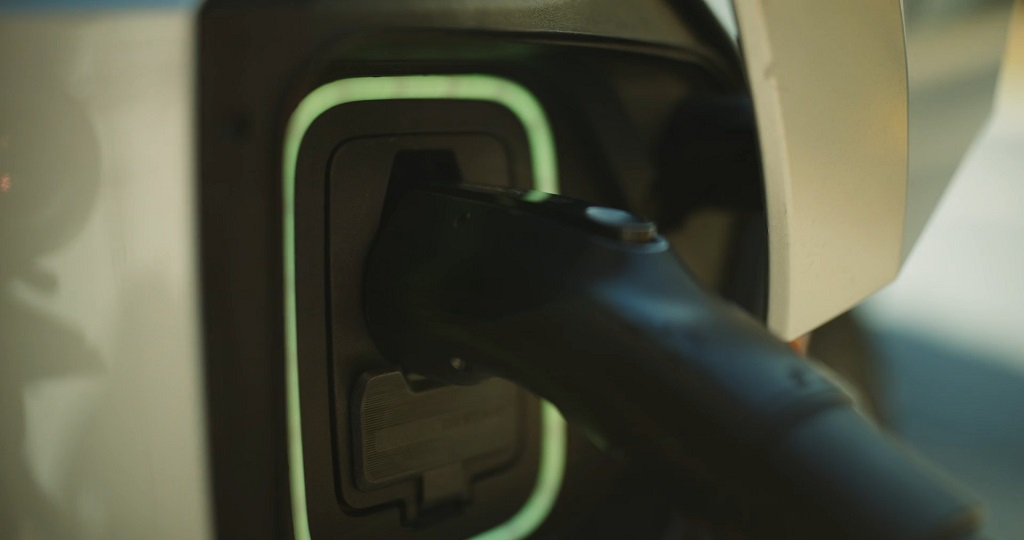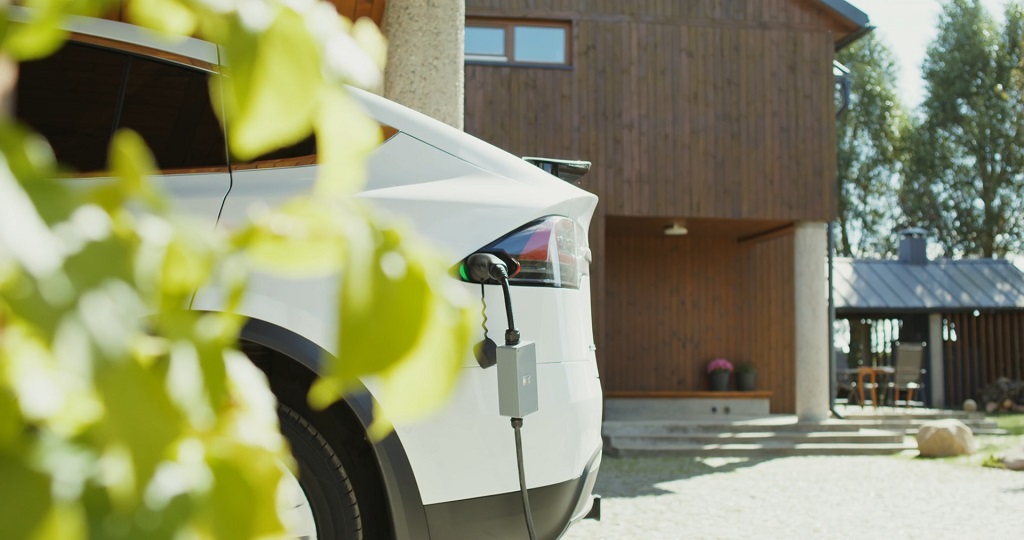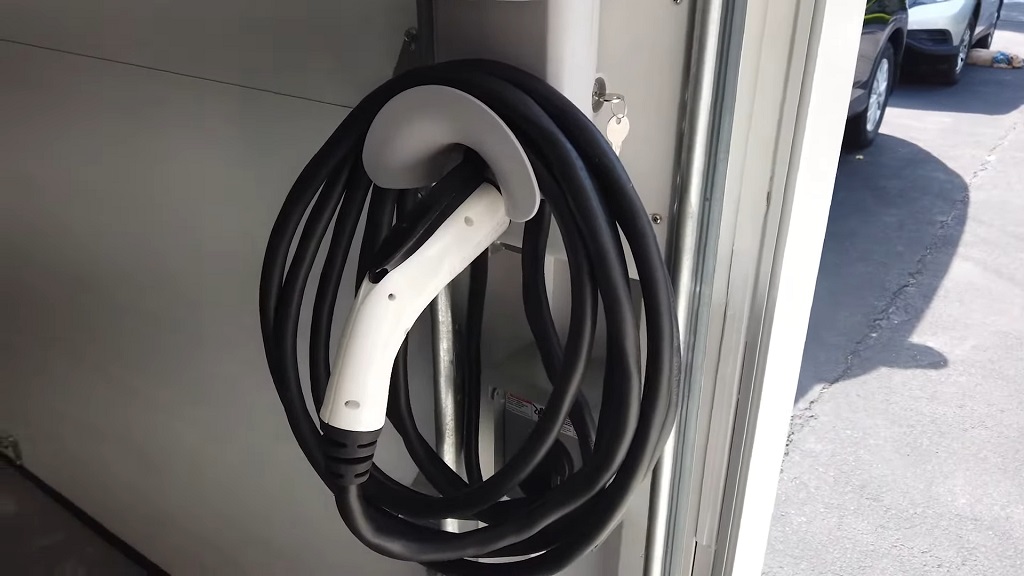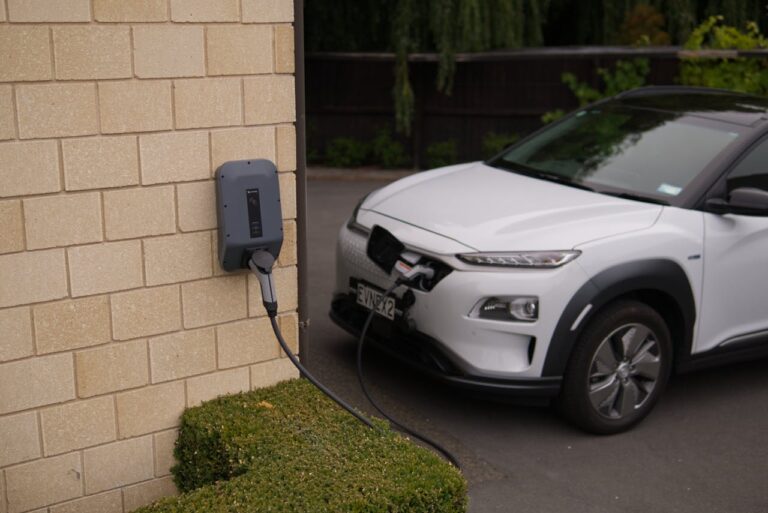A Level 2 EV charger is what makes driving an electric vehicle genuinely convenient. It’s fast enough to charge most EVs overnight, simple enough for home use, and common enough to be the backbone of the public charging network in the United States.
If you drive daily and want your car ready in the morning without waiting 40 hours to top off the battery, a Level 2 charger is likely what you need.
At its core, a Level 2 charger is a 240-volt electrical device that charges an electric vehicle significantly faster than the standard wall plug, which is only 120 volts. It uses the same voltage as your electric dryer or oven, but instead of cooking dinner or drying laundry, it fills your car with miles of range.
Most electric vehicles gain between 20 and 60 miles of range per hour using Level 2. That’s a huge leap from the trickle of 3 to 5 miles per hour you’d get with a Level 1 charger. It means that an EV battery, which might take two full days to recharge on a regular outlet, could be full in 8 hours or less using a Level 2 setup.
The key difference lies in power delivery. Level 1 chargers are fine for plug-in hybrids or very light daily driving, but once you cross 40 miles per day or rely solely on electricity for transportation, the slow trickle just doesn’t keep up. That’s when Level 2 becomes not just helpful, but necessary.
| Charger Type | Voltage | Charging Speed (Miles of Range/Hour) | Charging Time (0–100%) | Outlet Type |
| Level 1 (Standard) | 120V | 3–5 miles/hour | 24–48+ hours | Common home outlet |
| Level 2 (Upgraded) | 240V | 20–60 miles/hour | 4–10 hours | Dryer/stove outlet or installed unit |
| Level 3 (DC Fast) | 480V+ | 100–200+ miles in 30 minutes | ~1 hour or less | Commercial-only |
How Long Does It Take to Charge with Level 2?

Charging speed depends on the specific vehicle and the charger’s amperage, but most Level 2 chargers can fully charge an EV in about four to ten hours.
For example, a Tesla Model 3 or a Ford Mustang Mach-E can go from near-empty to full overnight. That timing fits into most people’s schedules without a second thought. Just plug in when you get home from work and wake up with a “full tank.”
This is why Level 2 is the standard recommendation by manufacturers and energy departments alike. It gives you freedom to drive your EV normally, without constantly calculating how many hours you’ll need to plug in.
Where Do You Find Level 2 Chargers?
They’re more common than you might expect. You’ll find Level 2 charging stations in office parking lots, grocery stores, schools, shopping centers, apartment buildings, and public garages. They’re also used in more than 80 percent of home charging setups, according to data from the U.S. Department of Energy.
That home usage matters. With a Level 2 charger installed in your garage or driveway, you’re not at the mercy of public infrastructure. You avoid waiting in line, fighting for a charger on road trips, or paying higher per-kWh rates at public stations.
According to the Department of Energy’s Alternative Fueling Station Locator, the U.S. has over 60,000 public Level 2 charging stations, compared to fewer than 10,000 DC fast-charging locations. This makes Level 2 the backbone of practical, everyday EV use, especially outside major cities.
Public access is growing as well, and many companies are now designing systems that accommodate both private and shared charging. According to resources from btcpower.com, which tracks and builds AC and DC charging solutions, there’s been a noticeable shift toward modular station design – systems that allow for scalable charging across commercial and residential installations.
This includes everything from wall-mounted home chargers to larger, multi-vehicle systems used in public garages and transit hubs.
What Does It Cost to Install a Level 2 Charger?
Costs vary depending on your home’s electrical system, but here’s a typical breakdown:
| Item | Price Range (USD) |
| Level 2 Charger Hardware | $400 – $900 |
| Professional Installation | $300 – $1,500 |
| Permits/Electrical Upgrades | $100 – $1,000+ |
| Total Cost Estimate | $700 – $3,000 |
The cost depends on a few things, like whether your house already has a 240-volt circuit available, what kind of charger you choose, and whether you need a professional to do upgrades to your electrical panel.
Generally, the hardware for a basic Level 2 charger starts at around $400 and can go up to $900 or more for models with smart features like Wi-Fi, scheduling, and remote monitoring. Installation can range from $300 to $1,500, depending on whether you’re adding a new circuit or upgrading your panel.
If your home already has a 240-volt outlet, like the kind used for electric dryers, and it’s in a good location, you might get away with just plugging in a charger with no major electrical work. But many homes do require professional installation, which may include running a new line or installing a dedicated circuit breaker.
On average, expect to pay between $700 and $2,500 for the full setup, although that number can go up if your home needs major electrical upgrades.
It’s also worth checking for rebates. Many states and utility companies offer incentives to install home EV chargers. In some cases, you can get up to $1,000 or more back through tax credits or rebates, reducing your out-of-pocket cost significantly.
What About Charging at Apartments or Shared Housing?

This is where things get more complex. Apartment dwellers and renters often don’t have the option to install their own Level 2 charger. But that’s slowly changing.
In many cities, building codes now require new apartment buildings to include EV-capable infrastructure. Some states, like California and New York, have passed laws giving renters the right to request charger installation, with landlords required to reasonably accommodate the request unless it’s overly expensive or impractical.
More apartment complexes are also adding Level 2 chargers to shared parking areas. If you’re considering EV ownership in an apartment, look into what’s already available or ask your property manager about plans for charging access.
Why Not Just Use a Level 1 Charger?
You can – technically. Every EV comes with a Level 1 charger that plugs into a standard wall outlet. But it’s very slow. You’ll only gain about four miles of range per hour. That might work for plug-in hybrids or people who drive less than 20 miles a day. But if you want to drive normally, charge overnight, and avoid range anxiety, it’s not ideal.
Level 2 isn’t just about speed – it’s about freedom. Being able to fully charge overnight means you can wake up and go wherever you want, without having to plan your day around a public charging stop.
Real-World Example: Charging a 300-Mile EV
Let’s say your EV battery can hold 300 miles of range.
- With a Level 1 charger, you’d gain about 4 miles per hour of charge.
- After 10 hours, you’d only have 40 miles – barely enough for a day of errands.
- With a Level 2 charger, you’d gain 30 to 40 miles per hour.
- After 10 hours, your battery would be full or very close.
That’s the difference between a tool that kind of works and one that meets your needs.
What Are the Best Level 2 Chargers?

There are dozens of models on the market now, but most fall into two main categories: smart chargers and basic chargers.
Smart chargers can connect to Wi-Fi and apps, allowing you to schedule charging when electricity is cheapest, track your energy use, or control the unit remotely. Basic chargers do the job without the extras.
Some of the top brands include ChargePoint, JuiceBox, Grizzl-E, Wallbox, and Tesla’s Wall Connector (which also works with other EVs using an adapter).
When choosing a charger, look at its amperage, compatibility with your vehicle, whether it’s plug-in or hardwired, and whether you want smart features.
Final Thoughts
If you own or plan to own a fully electric vehicle, a Level 2 charger is one of the most practical upgrades you can make. It turns EV ownership into a routine, not a puzzle.
You can drive more, wait less, and stop worrying about whether your car will be ready in the morning. And while the upfront costs can be significant, the long-term convenience and utility are worth it for most drivers.
In short, if you want your EV experience to feel seamless and low-maintenance, installing a Level 2 charger is the smartest move you can make.

